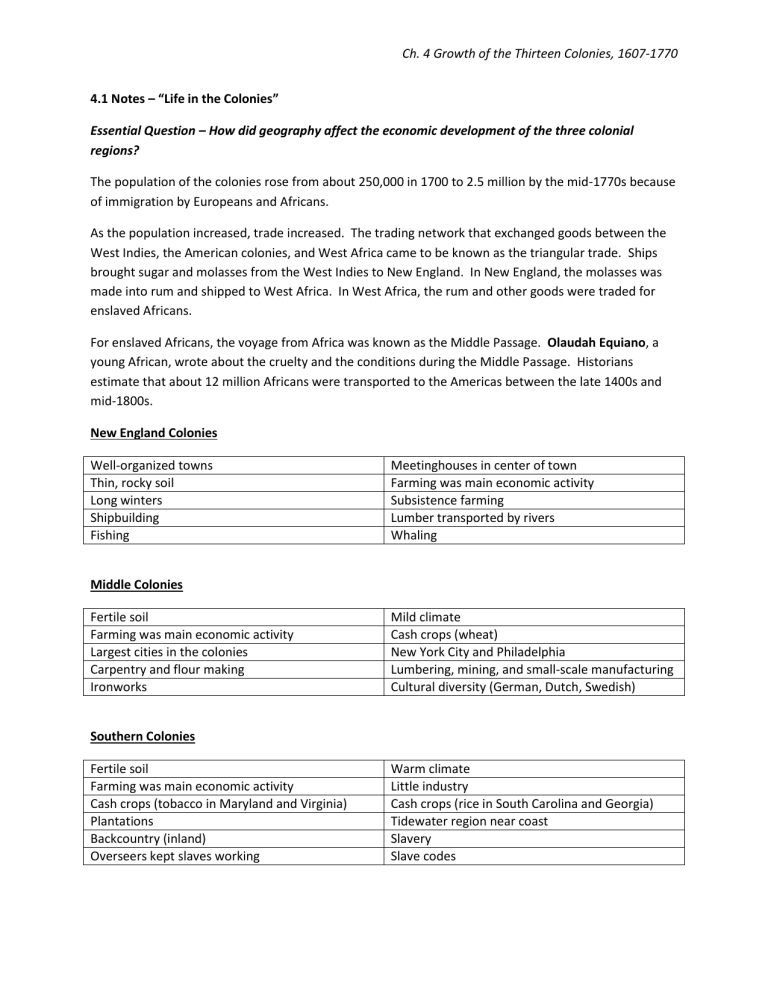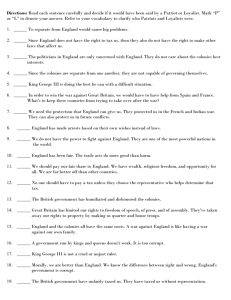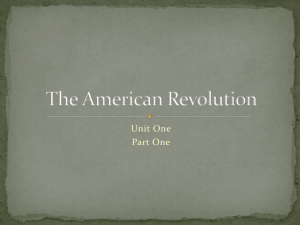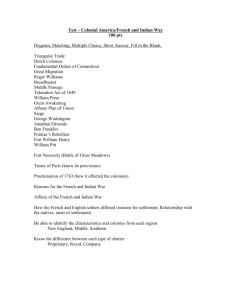Ch. 4 Growth of the Thirteen Colonies, 1607

Ch. 4 Growth of the Thirteen Colonies, 1607-1770
4.1 Notes – “Life in the Colonies”
Essential Question – How did geography affect the economic development of the three colonial regions?
The population of the colonies rose from about 250,000 in 1700 to 2.5 million by the mid-1770s because of immigration by Europeans and Africans.
As the population increased, trade increased. The trading network that exchanged goods between the
West Indies, the American colonies, and West Africa came to be known as the triangular trade. Ships brought sugar and molasses from the West Indies to New England. In New England, the molasses was made into rum and shipped to West Africa. In West Africa, the rum and other goods were traded for enslaved Africans.
For enslaved Africans, the voyage from Africa was known as the Middle Passage. Olaudah Equiano, a young African, wrote about the cruelty and the conditions during the Middle Passage. Historians estimate that about 12 million Africans were transported to the Americas between the late 1400s and mid-1800s.
New England Colonies
Well-organized towns
Thin, rocky soil
Long winters
Shipbuilding
Fishing
Middle Colonies
Fertile soil
Farming was main economic activity
Largest cities in the colonies
Carpentry and flour making
Ironworks
Southern Colonies
Fertile soil
Farming was main economic activity
Cash crops (tobacco in Maryland and Virginia)
Plantations
Backcountry (inland)
Overseers kept slaves working
Meetinghouses in center of town
Farming was main economic activity
Subsistence farming
Lumber transported by rivers
Whaling
Mild climate
Cash crops (wheat)
New York City and Philadelphia
Lumbering, mining, and small-scale manufacturing
Cultural diversity (German, Dutch, Swedish)
Warm climate
Little industry
Cash crops (rice in South Carolina and Georgia)
Tidewater region near coast
Slavery
Slave codes
Ch. 4 Growth of the Thirteen Colonies, 1607-1770
4.2 Notes – “Government, Religion, Culture”
Essential Question – In what ways was an American culture developing during the colonial period?
The Glorious Revolution in 1688 was when Parliament forced out King James and placed William and
Mary on the throne. This change demonstrated power of elected representatives over the king. William and Mary signed the English Bill of Rights in 1689 guaranteeing certain basic rights to all citizens.
England viewed its colonies as an economic resource. The colonies provided England with raw materials. English manufacturers used these materials to produce finished goods, and then sold them to the colonists. This process followed the economic theory of mercantilism. England made money by exporting more goods than it imported. To ensure that only England benefited from trade with the colonies, Parliament passed the Navigation Acts. The Navigation Acts prevented the colonists from trading with anyone other than England. These acts will later create conflict between England and the
American colonies.
The ideas of limited government and representative government influenced how the American colonies governed. Although still living under a monarchy, their town meetings developed into small governments responsible for making local laws.
There were three types of colonies in America:
Charter – setters were given a charter and elected their own governors and members of legislature
(Connecticut, Rhode Island)
Proprietary – proprietors, or individuals who were granted land, appointed the governor and members of an upper house of legislature; colonists elected the lower house (Delaware, Pennsylvania, Maryland)
Royal – directly ruled by Britain; the king appointed the governor and upper house; colonists elected the lower house (Georgia, Massachusetts, New Hampshire, New Jersey, New York, North Carolina, South
Carolina, Virginia)
Colonial legislatures did not allow everyone to vote. Only white men who owned property had the right to vote. Women, indentured servants, landless poor, and African Americans could not vote.
The Great Awakening was a religious movement that swept through the colonies between the 1720s and 1740s. It led to the formation of many new churches.
Religion, education, and the arts contributed to a new American culture.
The family formed the basic foundation of colonial society. Men were the heads of the household.
Women ran the household and cared for the children. Married women had few rights. Widows and unmarried women could run businesses and own property, but could not vote.
Ch. 4 Growth of the Thirteen Colonies, 1607-1770
Most colonists valued education. New England had a high literacy rate with about 85% of men and 50% of women able to read. Woman ran colonial schools. The colonies’ first colleges were founded to train ministers. Harvard in Massachusetts was the first in 1636.
By the 1700s, many educated colonists were influenced by the Enlightenment, a movement in Europe based on the idea that knowledge, reason, and science could improve society. In the colonies, the
Enlightenment increased interest in science. Benjamin Franklin was the most famous American scientist because of his experiments with electricity.
In 1735, John Peter Zenger faced charges of libel after printing an article criticizing the royal governor of
New York in the New York Weekly Journal. The jury found Zenger not guilty and today the case is regarded as an important step to the development of a free press in America.
Ch. 4 Growth of the Thirteen Colonies, 1607-1770
4.3 Notes – “France and Britain Clash”
Essential Question – Why did conflict arise in North America between France and Great Britain?
During the 1700s, Britain and France were two of the strongest powers in Europe. They competed for wealth and empire in different parts of the world. This rivalry caused bitter feelings between British and
French colonists in North America. Most of their dispute was over the Ohio River Valley.
Both the British and French knew that help from Native Americans could help them win control of North
America. The French had the advantage over the British and had many Native American allies. Because of fur trading, the French trappers and traders often married Native American women and followed their customs.
The most powerful group of Native Americans in the east was the Iroquois Confederacy (or League), based in the New York area. The Iroquois traded with both the British and the French and sometimes played both sides against each other. By the mid-1700s, the Iroquois became allies with the British after they had moved into the Ohio River Valley.
When a group of Virginians planned to settle in the Ohio River Valley in 1753, they sent 21-year-old
George Washington to lead the group. His mission was to tell the French that they were trespassing on
British territory and demanded them to leave. Washington delivered the message, but it did no good.
The French told him “it was their absolute design to take possession of the Ohio, and by God they would do it.”
In 1754, Washington, now a lieutenant colonel, was sent back to Ohio country with a militia with instructions to build a fort where the Allegheny, Monongahela, and Ohio Rivers meet – the site of present-day Pittsburgh. Washington and his troops arrived to find the French already building Fort
Duquesne on that spot. Washington built a small fort nearby and named it Fort Necessity. Washington attacked the French, but Washington was quickly forced to surrender. Even though he was defeated, the colonists considered Washington a hero because he stood up to the French.
Representatives from several colonies met in Albany, New York, in 1754 to discuss the threat of war.
Benjamin Franklin proposed the Albany Plan of Union for a united colonial government. America’s first political cartoon was drawn by Franklin to encourage the colonies to unite. However, no colonial assemblies approved The Albany Plan, and soon The French and Indian War began.
4.4 Notes – “The French and Indian War”
Essential Question – How did the outcome of the French and Indian War determine who controlled
North America?
Ch. 4 Growth of the Thirteen Colonies, 1607-1770
England was worried that France were taking control of all North America. They were building forts throughout the Great Lakes region and the Ohio River Valley. Their network of alliances with Native
Americans allowed them to control large areas of land.
After Washington’s defeat at Fort Necessity, General Edward Braddock was appointed commander-inchief of British forces in America. Braddock’s mission was to drive French forces out of the Ohio River
Valley.
In 1755, Braddock started from Virginia with 1,400 British redcoats and a small force of blue-coated colonial militia. George Washington was an aide to Braddock. Their goal was to march to Fort
Duquesne. Washington told Braddock that his army’s style of marching would not work when fighting on the frontier. They marched in columns wearing red uniforms, making them easy targets. Braddock ignored Washington’s advice. Native Americans and French troops ambushed the British. Braddock was killed and the British suffered almost 1,000 casualties. Washington and the survivors returned to
Virginia.
The French and Indian War in America started a new war in Europe also. This war was known as the
Seven Years’ War.
Early in the war, French troops captured many British forts at Lake Ontario and Lake George, including
Fort William Henry. Native American allies raided frontier farms in New York and Pennsylvania, killing settlers and burning farmhouses and crops.
When William Pitt was appointed as prime minister of Great Britain, the British chances for victory improved. Pitt decided that Great Britain would pay for the war supplies – no matter the cost. He also sent British troops under the command of Jeffrey Amherst and James Wolfe, who won many victories including the capture of Fort Duquesne, which was renamed Fort Pitt.
In 1759, at the Battle of Quebec, the capital of New France, Wolfe’s troops surprised and defeated the
French army on the Plains of Abraham. This is considered the deciding moment of the French and
Indian War.
The victory and Quebec and Amherst’s capture of Montreal brought an end to the French and Indian
War. The British victory marked the end of France as a power in North America. The terms of the
Treaty of Paris of 1763:
France forced to give Canada and most of its land east of the Mississippi River to Great Britain
Great Britain received Florida from Spain
Spain acquired French land west of the Mississippi and city of New Orleans
The French defeat was also bad for their Native American allies in the Ohio River Valley. British settlers began moving west onto Native American lands. Pontiac, chief of the Ottawa, united Native Americans against the British. In 1763, Pontiac’s forces captured British forts and killed settlers along the frontier.
This became known as Pontiac’s War. The war ended in 1765 when the British defeated Pontiac’s allies.
Ch. 4 Growth of the Thirteen Colonies, 1607-1770
To prevent more fighting with Native Americans, Britain passed the Proclamation of 1763 which made the Appalachian Mountains the western boundary for the colonies. The proclamation angered settlers who already lived west of the mountains. More conflicts would soon arise between Britain and the colonists.







